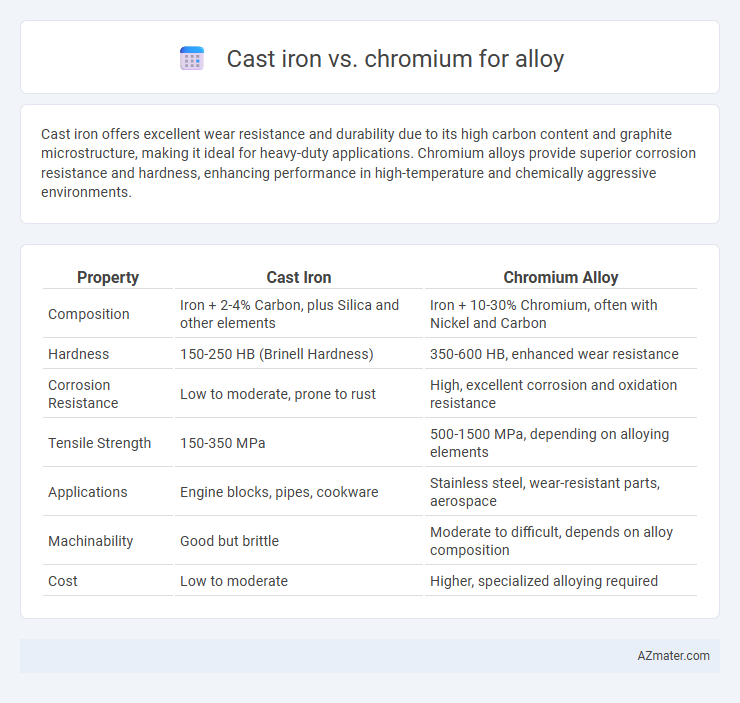Cast iron offers excellent wear resistance and durability due to its high carbon content and graphite microstructure, making it ideal for heavy-duty applications. Chromium alloys provide superior corrosion resistance and hardness, enhancing performance in high-temperature and chemically aggressive environments.
Table of Comparison
| Property | Cast Iron | Chromium Alloy |
|---|---|---|
| Composition | Iron + 2-4% Carbon, plus Silica and other elements | Iron + 10-30% Chromium, often with Nickel and Carbon |
| Hardness | 150-250 HB (Brinell Hardness) | 350-600 HB, enhanced wear resistance |
| Corrosion Resistance | Low to moderate, prone to rust | High, excellent corrosion and oxidation resistance |
| Tensile Strength | 150-350 MPa | 500-1500 MPa, depending on alloying elements |
| Applications | Engine blocks, pipes, cookware | Stainless steel, wear-resistant parts, aerospace |
| Machinability | Good but brittle | Moderate to difficult, depends on alloy composition |
| Cost | Low to moderate | Higher, specialized alloying required |
Overview of Cast Iron and Chromium Alloys
Cast iron is a carbon-rich alloy primarily composed of iron, carbon (2-4%), and silicon, known for its excellent castability, wear resistance, and compressive strength, commonly used in heavy-duty machinery and automotive components. Chromium alloys, often alloyed with steel, contain chromium content ranging from 10% to 30%, offering superior corrosion resistance, hardness, and oxidation resistance, making them ideal for stainless steel and high-performance industrial applications. The distinct composition and properties of cast iron and chromium alloys determine their suitability across construction, manufacturing, and decorative industries.
Composition and Microstructure Differences
Cast iron primarily consists of iron, carbon (2-4%), and silicon, with microstructures dominated by graphite flakes or nodules embedded in a pearlitic or ferritic matrix, which significantly affects its brittleness and wear resistance. Chromium alloys incorporate higher chromium content (typically above 10%) with iron, forming complex carbides and a predominantly martensitic or austenitic microstructure, enhancing hardness, corrosion resistance, and toughness. The essential difference in composition--low carbon with graphite in cast iron versus chromium-rich carbides in chromium alloys--results in distinct microstructural phases that define their mechanical and chemical performance characteristics.
Mechanical Properties Comparison
Cast iron exhibits high compressive strength and excellent wear resistance, making it suitable for heavy-duty applications, while chromium alloys offer superior tensile strength and enhanced corrosion resistance, ideal for environments requiring durability and oxidation protection. Chromium's ability to maintain structural integrity at elevated temperatures surpasses cast iron, contributing to better thermal stability and fatigue resistance. The hardness of chromium alloys, combined with their toughness, typically results in improved impact resistance compared to the more brittle nature of cast iron.
Corrosion and Wear Resistance
Cast iron alloys exhibit excellent wear resistance due to their high hardness and graphite microstructure, which provides self-lubricating properties, but they are prone to corrosion without protective coatings. Chromium alloys significantly enhance corrosion resistance through the formation of a stable oxide layer, making them ideal for harsh environments, while also improving wear resistance by increasing surface hardness and reducing friction. Choosing between cast iron and chromium alloys depends on the balance between mechanical wear demands and exposure to corrosive conditions in specific applications.
Common Industrial Applications
Cast iron alloys are widely used in heavy machinery, automotive engine blocks, and construction due to their excellent wear resistance and high compressive strength. Chromium alloys are favored in aerospace, chemical processing, and stainless steel production for their superior corrosion resistance and hardness. Both materials play critical roles in manufacturing industrial tools, with cast iron excelling in durability and chromium enhancing surface protection.
Machinability and Workability
Cast iron exhibits excellent machinability due to its graphite content, which acts as a natural lubricant, allowing easier cutting and shaping compared to chromium alloys. Chromium alloys offer superior workability in terms of hardness and corrosion resistance but are more challenging to machine because of their toughness and tendency to work-harden. Selecting between cast iron and chromium depends on balancing ease of machining with desired mechanical properties for specific applications.
Heat Resistance and Thermal Stability
Cast iron offers excellent heat resistance due to its high carbon content and graphite structure, making it ideal for applications involving slow heating and gradual temperature changes. Chromium alloys provide superior thermal stability with their ability to maintain strength and resist oxidation at elevated temperatures, especially in environments exceeding 1000degC. While cast iron excels in heat retention and vibration dampening, chromium alloys outperform in maintaining mechanical integrity under rapid thermal cycling and extreme heat conditions.
Cost and Availability
Cast iron generally costs less due to its abundance and simpler manufacturing process, making it widely available for industrial applications. Chromium, as an alloying element, is more expensive because it requires complex extraction and refinement, limiting its overall availability. The cost difference significantly impacts material choice, with cast iron favored for budget constraints and chromium preferred for enhanced corrosion resistance despite higher expense.
Environmental Impact and Recycling
Cast iron features high recyclability due to its widespread use and established recycling infrastructure, significantly reducing landfill waste and energy consumption compared to primary production. Chromium, often alloyed with steel to enhance corrosion resistance, poses environmental challenges linked to mining and processing toxic compounds but can be partially recovered during stainless steel recycling. The environmental impact of both hinges on efficient recycling practices that minimize raw material extraction and mitigate pollution associated with chromium's chemical toxicity.
Choosing the Right Alloy for Your Needs
Choosing the right alloy depends on the application requirements, as cast iron offers excellent wear resistance and compressive strength, making it ideal for heavy-duty machinery and engine components. Chromium alloys provide superior corrosion resistance and hardness, suitable for environments exposed to high temperatures and chemical exposure. Evaluating factors such as mechanical stress, environmental conditions, and desired lifespan ensures optimal performance by selecting either cast iron or chromium-based alloys.

Infographic: Cast iron vs Chromium for Alloy
 azmater.com
azmater.com